(print this out and take it with you on your next visit to Perth)
Perth Tour 1 Perth Tour 2 Perth Tour 3 Perth Tour 4
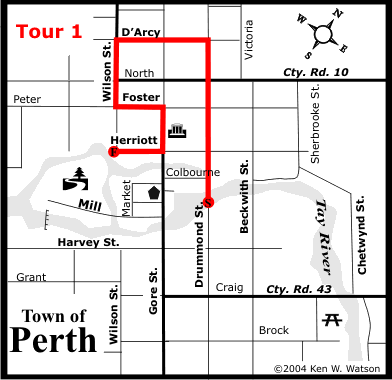 |
Original walking tour pamphlet designed by the Perth Local Architectural Conservation Advisory Committee |
Perth – Centre Ward – West
On this tour you will see:
- the Tay Basin - connected to the Rideau Canal system since 1832
- the Perth Courier offices in operation since 1834 - on Gore St. East
- the Bank of Montreal - on Gore St. East since 1850
- Shaw's store - on this corner of Gore St East since 1858
- Girdwood's Pharmacy - dispensing medications here on Foster Street since 1871
- Sinclair's Florists - on Gore St. West since 1890
- James Brothers - on Gore St. East since 1892
- the Farmer Block - a housing unit in the Farmer family since 1892 - on D'Arcy Street
Start at the Bridge on Drummond Street which overlooks the Tay Basin. Realize that Perth was originally started on islands in the Tay River. The basin was used for turning larger boats and for docking as people and merchandise were transported up the Rideau Canal.
Walk along Drummond Street to Herriott Street, noting the Crystal Palace by the Tay Basin; this houses the summer market and various other specialty gatherings during the year.
On the left, at the corner of Herriott Street, is the Perth Library. From this corner it is possible to see several places of interest on Herriott Street … to the left ….
Herriott Street
30 Herriott - The Library, 1981 – this replaces one on Gore Street that burned down in 1980
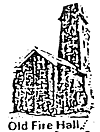 34 Herriott - Old Fire Hall, 1855. In 1883 the second floor and hose tower were added and the building was used for that purpose until the 1940s - now it is used by the Chamber of Commerce. 34 Herriott - Old Fire Hall, 1855. In 1883 the second floor and hose tower were added and the building was used for that purpose until the 1940s - now it is used by the Chamber of Commerce.
27 Herriott built in 1834, this building was moved here from site of Matheson House at 11 Gore Street East
29 Herriott built in 1898. Dr. A.W. Dwyre's office - who in 1904 installed an Xray machine.
… and to the right on Herriott Street and along the right side of Drummond Street there is a community of houses combining stucco and brick that were built during the latter part of the first world war by the Wampole Company as housing for employees.
Continue along Drummond Street. At North Street, note that until 1851 this was the town limits. By that time people had been building in the park lands beyond the edge of town, so the town acquired lands from Drummond Township and Perth expanded.
Drummond Street East
4 Drummond East - Built in 1904 for the local merchant Henry Shaw, of Shaw's 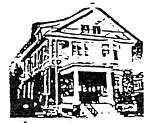 Department Store, it remained in the family for 85 years. This house was noted for its unique wainscoting and hand tooled wallpaper. It was rumoured to have a resident ghost Department Store, it remained in the family for 85 years. This house was noted for its unique wainscoting and hand tooled wallpaper. It was rumoured to have a resident ghost
31 Foster Street – at the corner of Drummond and Foster. It was built in 1864 of 24 inch sandstone blocks for William Shaw. His family lived here until 1898. It was bought in 1917 and became the Thomas Caldwell residence. He represented North Lanark in the Federal Parliament under Sir Wilfred Laurier. During Caldwell’s time, a stone addition was added to the rear where stables had previously been. In 1942 the new owner had the building divided into apartments. In 1988 a law firm took it over for their offices.
Drummond Street West
1 Drummond West - St Andrew's Presbyterian Church - This church opened March 11th 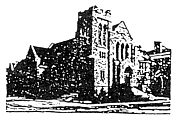 1928, just five years after the original church had been destroyed by fire. In 1930 the church was presented with the bell from First Presbyterian Church, which, in 1867, had also been destroyed by fire. This bell hangs in the Church Tower. St Andrew's Hall (next door, facing on Foster Street) was purchased in 1921 from the Merchants’ Bank. 1928, just five years after the original church had been destroyed by fire. In 1930 the church was presented with the bell from First Presbyterian Church, which, in 1867, had also been destroyed by fire. This bell hangs in the Church Tower. St Andrew's Hall (next door, facing on Foster Street) was purchased in 1921 from the Merchants’ Bank.
3 Drummond West - built in 1924-5 of local quarried stone for Lawrence James of James Brothers Hardware Store, on the site of his father's blacksmith shop.
4, 6 & 8 Drummond West - composite building, the stone portion on the corner dates to 1840, the board and batten portion to 1863 and the stone bungalow (formerly a blacksmith's shop) to 1832.
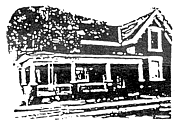 10 Drummond West, 1860 - This lovely Victorian home is believed to be stone underneath the stucco. Every one of the spacious rooms is filled with light, and the large wrap-around veranda catches even the softest of summer breezes. 10 Drummond West, 1860 - This lovely Victorian home is believed to be stone underneath the stucco. Every one of the spacious rooms is filled with light, and the large wrap-around veranda catches even the softest of summer breezes.
12 Drummond West, 1835 – Neoclassical stone house of superior design.
Continue along Drummond to D’Arcy Street. From this corner you can see the grounds of the Perth Manor on Drummond with its stone garden wall. This was the home of the Stewarts, whose name is given to the town park and one of Perth’s schools. Turn left on D’Arcy Street.
D'Arcy Street
11 D'Arcy, built in 1846 - Built by James Robertson, stonemason. From 1862-65 this 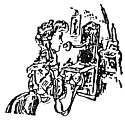 house was occupied by the Baptist minister, the Rev. Thomas Henderson, long time friend in Edinburgh of Alexander Melville Bell. Rev. Henderson was largely responsible for persuading the Bell family to emigrate to Canada for the sake of their only surviving son (Alexander Graham Bell) who was in poor health. The inventor of the telephone maintained his contact here. His father presented the second telephone set to Rev. Henderson. It was connected from this house to the residents dental office on Foster Street in 1876. Rev. Henderson (father-in-law of the dentist) is buried in the Elmwood Cemetery here in Perth. In 1954 the Telephone Pioneers of America placed a bronze plaque on his grave to commemorate his contribution to the early establishment of the telephone. house was occupied by the Baptist minister, the Rev. Thomas Henderson, long time friend in Edinburgh of Alexander Melville Bell. Rev. Henderson was largely responsible for persuading the Bell family to emigrate to Canada for the sake of their only surviving son (Alexander Graham Bell) who was in poor health. The inventor of the telephone maintained his contact here. His father presented the second telephone set to Rev. Henderson. It was connected from this house to the residents dental office on Foster Street in 1876. Rev. Henderson (father-in-law of the dentist) is buried in the Elmwood Cemetery here in Perth. In 1954 the Telephone Pioneers of America placed a bronze plaque on his grave to commemorate his contribution to the early establishment of the telephone.
15 D'Arcy, built in 1851 - Known as part of the Farmer Block, this structure was added to the existing stone house next door, with a concert hall upstairs which was accessed by an outside staircase from the laneway. The ornate plaster ceiling still decorates the attic. Opera singers from New York City came to sing here before Bytown (Ottawa) was important The lower floor was used as a leather goods shop and residence, later a medical office and by the turn of the century was two homes 13 and 15 D’Arcy Street. In the 1940s they were divided into four apartments with a common door at No.15
17 D'Arcy, built in 1888 - The present brick Baptist Church was built to replace a frame structure built in 1842. The estimated cost of the new building (in 1888) was $5500. During the time between the demolition of the old building and the completion of the new building, services were held in the Music Hall next door.
21 D'Arcy, built in 1863 - A parsonage for First Baptist Church, the house remains as originally built with a modification in 1925 which raised the roof to provide a full second storey.
On the corners of D’Arcy and Gore Streets are St. Paul’s United Church and its manse.
25 Gore Street West, 1854 stone building - St Paul's United Church, was formerly Knox Presbyterian Church. The Free Church Party organized this Presbyterian Church in 1845. In 1925 it became part of the new United Church of Canada and in 1926 took the name "St Paul's United Church". In 1964 extensive brick wings were added for Christian Education.
20 Gore Street West, 1860 - St. Paul’s United Church Manse -
Designed by a Montreal architect in the Gothic Revival style, the house was built in 1870 by a local contractor, Duncan Kippen, for a cost of
approximately $3200. The first resident of the Manse was Rev. William Burns who moved in with his family on October 20th 1870. Since then it has been home to eleven church ministers and their families. Originally known as the Knox Free Presbyterian Church Manse, it became St. Paul’s United Church Manse in 1926. The Manse finally left church hands in November 2004 when it was sold to Bruce and Anne Neil of Ottawa who currently occupy the old manse as a private home.
Look left on Gore Street to notice Sinclair’s Florist (in Perth since 1890). Continue along D’Arcy Street and on the left a stone building …
30 D’Arcy, built in 1834 – this stone building was the site of the first Grammar School, a temporary location until a combined Public and Grammar school could be built in 1852.
Turn left on Wilson Street
Wilson Street West
27 Wilson, built in 1844 - One of the oldest hotels in Perth. Barrie's Hotel 1844-1919, from 1919-1970 the Imperial Hotel, and continued as a Hotel until 1983.
22 Wilson, built in 1850, known locally as “The Doctor's House” was registered to L.A.C.A.C. in 1986.
As you cross North Street you are once again returning to the original site of the Town of Perth.
2 Wilson, built in 1946. An Art Deco style building, built by J. Perkins as a car showroom and garage.
At the corner of Wilson and Foster, turn left on Foster.
Foster Street
80 Foster, built in 1835 - Black Sandy Ferguson Hotel. From 1869 -1983 it was known as the Revere Hotel, and since 1983 as the Red Fox Tavern.
57 Foster, built in 1835 - This shop has served as a drug dispensary since 1871 and is now renamed from Girdwood's Drug Store.
39 Foster, built in 1862. This is where Dr. Kennedy had his dental office which was connected by the first telephones to his home on D'Arcy Street.
at the corner of Foster and Gore Streets, turn right on Gore.
Gore Street
1 Gore Street West - From 1838 until 1979 this property was known as the Hotel Perth. In 1958 a fire on the third floor led to the remodelling of the building and removal of that top floor. A wayside inn on this site operated as early as 1817.
2 Gore Street East, James Brothers -This building was constructed in 1840, and the hardware shop (1892) owned by George James and D. Reid moved to this location in 1910. They renovated and added a third floor. With a machine shop and foundry they were able to make, sell and service many of their own products. Lawrence James joined the firm and after 1921 it became known as James Brothers. Both brothers continued to work in the store well into their old age.
1 Gore Street East, 1840 - Roderick Matheson built this store as a saddle and harness shop. In 1858 when one of his daughters married Henry Shaw of Smiths Falls it would become one of the oldest family operated stores in Canada. In the early years its merchandise came up the St Lawrence from Britain to Montreal then to Perth by barge via the Rideau and Tay Canals. A registered L.A.C.A.C. building in 1984.
11 Gore Street, built in 1840 – Matheson House – Perth’s Museum – It displays three 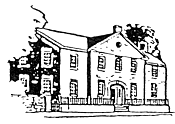 rooms restored to the period of its building in 1840 by Roderick Matheson. Other rooms are devoted to travelling exhibits. Matheson was Perth's first banker and original owner of the neighbouring store, now Shaw's. He became a life member of the Upper Canada Legislative Council and a Confederation Senator. This home remained in the possession of the Matheson family for nearly 100 years. From 1931 to 1947 it was a Bed and Breakfast as well as a Tea Room. From 1947 to 1965 the building was used as a Legion Hall and in 1966 was converted to a Museum. rooms restored to the period of its building in 1840 by Roderick Matheson. Other rooms are devoted to travelling exhibits. Matheson was Perth's first banker and original owner of the neighbouring store, now Shaw's. He became a life member of the Upper Canada Legislative Council and a Confederation Senator. This home remained in the possession of the Matheson family for nearly 100 years. From 1931 to 1947 it was a Bed and Breakfast as well as a Tea Room. From 1947 to 1965 the building was used as a Legion Hall and in 1966 was converted to a Museum.
30 Gore, built in 1884 - Bank of Montreal. Built of white Bathurst sandstone, this Queen Anne-style building once housed the bank manager and his family on the second and third floors. Note the sun motif under the front gable.
39 Gore, built in 1848- Part of the Kellock Block, it has housed the Perth Courier from 1898 to the present. The paper was founded in 1834 and is the second oldest newspaper in Canada. The Walker family, ancestors of the present owner, bought it in 1852. A registered L.A.C.A.C. building in 1984.
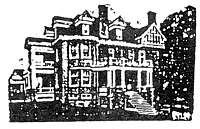 50 Herriott - "Kininvie" built of reddish sandstone in 1906 for textile manufacturer Thomas A. Code. This grand Edwardian residence is said to have been heated by steam from the factory across the street. Unlike earlier "walled garden" homes, the Code mansion gloried in its open expansive lawns and garden overlooking the Tay River. 50 Herriott - "Kininvie" built of reddish sandstone in 1906 for textile manufacturer Thomas A. Code. This grand Edwardian residence is said to have been heated by steam from the factory across the street. Unlike earlier "walled garden" homes, the Code mansion gloried in its open expansive lawns and garden overlooking the Tay River.
51 Herriott - The Code Mill is actually a collage of five different buildings dating from 1842. T.A. Code moved to Perth in 1876, and bought this property by 1883. Code spent 60 years in business in Perth. The business started with a contract to supply the North West Mounted Police with socks, and continued for many years manufacturing felt for both industrial and commercial uses. The mill is now in the process of conversion to an upscale eatery "Fiddleheads" and office building.
From this corner Herriott and Wilson you can look across the Tay River to see Stewart Park and Bolt Factory
Stewart Park is located on part of both islands in the centre of Perth. It was designed, constructed and for many years maintained by Jessie Stewart as a memorial to her husband, the Honourable John Alexander Stewart. Educated in Perth and Toronto, John Stewart practiced law here from 1895 until his death in 1922 at the age of 55. He had been the President of the Henry K. Wampole Co. Ltd., the Andrew Jergens Company Ltd., and Perth Co. Ltd. He served the town well as a councillor and as Mayor from 1900 to 1904.
Elected to the House of Commons in 1918 he served as Minister of Railways in the Meighen administration. In 1947 the park was conveyed to the town with an endowment fund to provide for maintenance. Mrs. Stewart placed a condition on the gift that the park should remain in essentially the same condition and not be used for any sort of commerce.
The Old "Box - Bolt or Bottling" Factory, 1883 - Overlooking the Tay River (with a small bridge crossing the Tay to Stewart Park) this old factory has been converted into upscale condominiums. A picture of this building is the one used by Reader's Digest and the Canadian Automobile Association as the most picturesque building in Perth, in their guide of places to visit across Canada.
This walking tour was designed by the Perth Local Architectural Conservation Advisory Committee (LACAC). n.d.
Digital versions created in 2004 by Ken W. Watson.
|